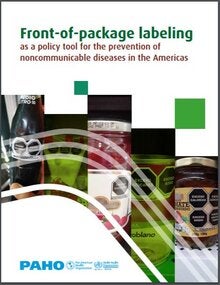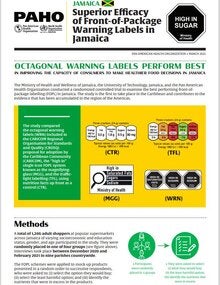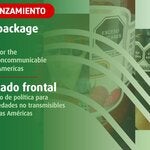Background
Noncommunicable diseases (NCDs) remain leading causes of mortality, morbidity and disability in the Caribbean. Three conditions, namely high blood pressure, high fasting blood sugar levels and overweight and obesity, are the main drivers of this disease burden in the region. This crisis is being further aggravated by the COVID-19 pandemic, as persons living with NCDs (PLWNCDs) face a greater risk of becoming severely ill or dying from COVID-19.
High blood pressure, high fasting blood sugar levels and overweight and obesity are closely linked to unhealthy diets, and an excessive intake of sugars, total fats, saturated fats, trans fats and sodium. In turn, the excessive intake of these “critical nutrients” of public health concern, is largely driven by the widespread availability, affordability and promotion of processed and ultra-processed food products with unhealthy nutritional profiles.
Front-of-Package Warning Labeling
Against this backdrop, an essential part of the solution requires the use of laws and regulations to reduce the demand for and offer of processed and ultra-processed products that contain excessive amounts of critical nutrients. Front-of-package warning labeling represents one of the key policy tools of a comprehensive strategy to regulate obesogenic environments. Scientific evidence shows that octagon-shaped front-of-package nutritional warnings indicating if a product is “HIGH IN” on or more critical nutrients, is the best performing system to allow consumers to correctly, quickly, and easily identify products with unhealthy nutritional profiles.
Moreover, this approach has been supported as a rights-compliant response in a recent Statement by the UN Rapporteur on the Right to Health, which highlighted States’ obligations to adopt regulatory measures aimed at tackling NCDs. As part of this approach, The PAHO nutrient profile model allows the identification of products that should contain warnings on the front of the containers for their excessive content of critical nutrients that can affect health.
FOPWL is a simple, practical and effective tool to inform the public about products that can harm health and help guide purchasing decisions
Situation in the Caribbean
In the Caribbean, the CARICOM Regional Organisation for Standards and Quality (CROSQ) is leading, since 2018, the revision of the (2010) CARICOM Regional Standard for Specification for labelling of pre-packaged foods (CRS 5:2010) to incorporate front-of-package labeling specifications.
This process is supported by strong regional mandates and has involved extensive consultations through National Mirror Committees with all relevant stakeholders, including industry and commerce. The current CARICOM draft standard meets the highest level of scientific excellence, including the octagon-shaped warning system and a nutrient profile model based on WHO recommendations.
Frequently Asked Questions
- A sign per se does not imply a violation. When applied to traffic, for example, a stop sign simply means the driver must stop before proceeding. Hence, the existence of a stop sign does not mean or indicate a legal violation.
- The purpose of nutrition warning systems is to inform consumers in a quick, correct, and easy way if a product contains excessive amounts of sugars, fats, and/or sodium. It does not forbid consumers from buying products; it helps them to quickly and easily make an informed decision.
- Any measure to modify public behavior should form part of a suite of complementary policies supported by a comprehensive public education program and nutritional labeling is no exception.
- Education and information campaigns are indeed important. However, such measures are not alternatives or substitutes for FOPL or any other policy; they are complementary.
- FOPL is an education tool in itself as it provides information that helps educate consumers about the content of food products.
- Compared with media campaigns, FOPL is more cost-effective given the reach and large self-sustainability over time.
- Furthermore, a campaign to inform the population about healthy meals, by itself, would not allow consumers to know in a quick and easy way which products are high in sugars, fats, and/or sodium. Rather, a FOPL that fits that purpose must be concomitantly in place.
- The evidence is consistent in demonstrating that consumers employ little cognitive effort and time in deciding their purchases. A large and growing body of scientific evidence consistently shows that FOPL nutrition warning systems work best to quickly, easily, and correctly inform consumers when products contain excessive amounts of nutrients related to noncommunicable diseases and to improve purchase intention and decision.
- The FOPL nutrition warning system is clear about its focus and purpose. The more purposes expected from a system, the less focused and less effective it will become in achieving its purpose or multiple purposes.
- The purpose of nutrition warning systems is to help the population identify products that contain excessive amounts of critical nutrients such as sugars, total fats, saturated fats, trans fats, and sodium. These nutrients should be the basis of the FOPL. Merging or adding information about positive nutrients or attributes into the FOPL system would divert its purpose, dilute the effect, and increase consumer confusion.
- FOPL systems that present positive nutrient or positive attributive information are not an appropriate vehicle to fit the purpose abovementioned (i.e., to help the population identify products that contain excessive amounts of critical nutrients) and to promote healthy diets, for several reasons.
- They may stimulate excessive consumption of processed and ultra-processed products that would not be recommended as part of a healthy diet because they add a health halo effect and the misperception that the product in question is healthy.
- They distract consumers from dietary recommendations that should be addressed by using other policy tools and vehicles of information, not the label of pre-packaged products;
- Claims such as “low in sodium” could generate an excessive consumption of ultra-processed products so labeled and subsequent excessive intake of sodium and/or other critical nutrients. This could be caused by the combination of hyperpalatability of such products and the stimuli of claims
- Studies have demonstrated that when consumers are rating the healthfulness of a product that has excessive amounts of sugars, fats, or sodium, adding the green color (perceived as a positive feature) to the FOPL system distorts their perception, making consumers believe that the product is healthier than it really is, or that it is recommended as part of a healthy diet when it is not.
- Products carrying front-of-package nutrition warnings are typically ultra-processed food and drink products that apart from having excessive amounts of critical nutrients, are associated with lower intake of positive nutrients such as vitamins, minerals, protein, and fiber. Hence, while FOPL nutrition warning systems focus on excessive amounts of critical nutrients, consumers are more likely to increase consumption of positive nutrients as well as avoid excessive amounts of sugars, total fats, saturated fats, trans fats, and sodium as they improve their purchase decisions due to the nutrition warning label.
- Consumer preference is not a parameter that measures the performance of a FOPL system and helps identify the most effective one. Hence, studies or assertions that indicate a system is preferred by consumers do not help in identifying the system that best suits the intended public health purpose.
- Evidence does not support the argument that traffic light systems leave more room for consumer choice and facilitate reading and understanding of the products’ nutritional components, when compared with nutrition warning systems. In fact, independent scientific evidence has demonstrated the opposite:
- The use of the traffic-light system has been proven to be less effective in informing consumers when products contain excessive amounts of sugars, fats, and/or sodium compared with use of the nutrition warning systemadopted in Chile, Mexico, Peru and Uruguay, and proposed for use in Brazil, Canada, and other countries.
- The traffic light system has been proven to be less effective in influencing consumer purchase intentions and decisions.This lower efficacy or lower performance has been explained by several scientific studies showing that:
- consumers can get confused when exposed to traffic light labels that are simultaneously high, medium, and/or low on different nutrients
- consumers struggle with and take more time identifying whether a food product carrying a traffic-light FOPL is excessive in a given nutrient
- the green sign for some products may work as a stimulus for the purchase of products that may be green in sodium, but are red in sugar, which could result in an undesirable increased consumption of these products.
- Since the 1970’s, marketing and consumer research has demonstrated that consumers employ little time and cognitive effort in making a purchase decision, especially when it comes to repetitive purchases, which is the case for food and drink products. The traffic light system requires more cognitive effort and more time for consumers to process and decide, when compared with the nutrition warning system.
- In addition to this evidence, it is also known that green-red color blindness is the most common form of color blindness, which means the measure would exclude part of the population from having the information.
- The traffic light system has been adopted voluntarily also because companies realized they could increase the sales of non-recommended products.Sugary drink companies adopted it voluntarily as a marketing strategy to upscale their sales by featuring the green light for sodium and fats in their sugary products.
- In order to protect consumers, FOPL systems that may be used as part of a marketing strategy to leverage the purchase of superfluous and unhealthy products should be avoided. For more details see PAHO’s Technical Brief for a summary of the purpose of FOPL and comparison of the performance of different systems.
- Hybrid systems combining GDA and traffic light systems have the same limitations described in #4. In addition, the colored GDA does not include text that interprets the quantitative amounts of listed nutrients. For more details see PAHO’s Technical Brief for a summary of the purpose of FOPL and comparison of the performance of different systems.
- In addition, FOPL systems that provide overall or summary nutrient scores do not allow consumers to clearly and quickly identify products that contain excessive amounts of critical nutrients (i.e., nutrients associated with the most burdensome diseases), such as sugars, total fats, saturated fats, trans fats, and sodium. For more details see PAHO’s Technical Brief for a summary of the purpose of FOPL and comparison of performance of different systems.
Featured Publications
Front-of-package Labeling as a Policy Tool for the Prevention of NCDs in the Americas
This technical brief summarizes the evidence on the performance of FOPL systems in meeting this purpose and provides a list of frequently asked questions about the nutrition warning system.
Pan American Health Organization Nutrient Profile Model
This Plan of Action mandates that PAHO provide evidence-based information for the development of fiscal and other types of policies and regulations to prevent the consumption of unhealthy foods, including front-of-package (FOP) labeling and Regional nutrition guidelines for school food environments.
Superior Efficacy of Front-of-Package Warning Labels in Jamaica
This fact-sheet presents the results of the first study to take place in the Caribbean to examine the best performing front-of-package labeling (FOPL).
Videos
Octagon High in Warning Labels the Best Way to Go for the Caribbean - Not the Magnifying Glass
Dr. David Hammond, Professor CIHR, PHAC Chair in the Applied Public Health School of Public Health & Health Systems, University of Waterloo, Canada presents the evidence that supports octagon high in front of package warning labels as the most effective food label to support consumers purchase of foods low in sugars, fats and salts - the nutrients associate with obesity and NCDs when consumed in excess.
The presentation is part of the webinar "Human Rights Approach to Front-of-Package-Labeling in the Caribbean", on November, 9th, 2020.
Related
Campaign
Now More Than Ever: Better Labels, Better Choices, Better Health























